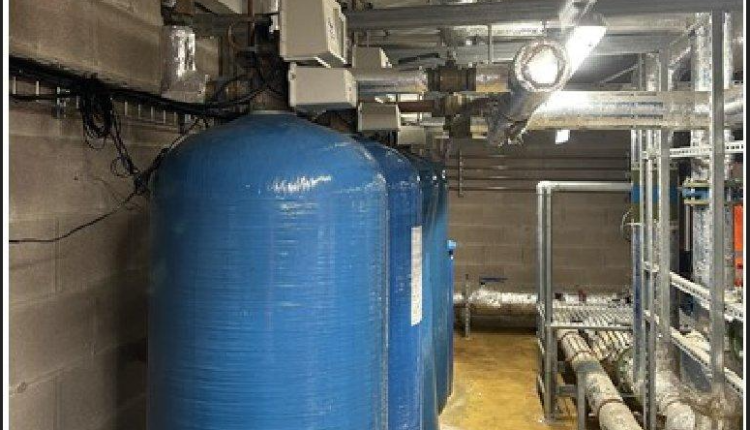Single vessel softeners vs Duplex vessel Commercial Water softening Systems
- Duplex water softeners provide an uninterrupted soft water supply during regeneration cycles, while single-vessel systems experience downtime
- Commercial establishments like hotels and universities benefit significantly from water softening systems to prevent limescale damage to plumbing and equipment
- The Fleck 2750, 2900, and 3900 are popular single-vessel softener models with either mechanical or digital control options
- Duplex systems like the Autotrol Logix 764 and Fleck 9500 are ideal for businesses that cannot afford any interruption in soft water supply
- Aquamaster Water Treatment Ltd specialises in commercial water softening solutions that protect vital equipment and reduce maintenance costs
Why Your Business Needs Uninterrupted Soft Water
Hard water isn’t just a nuisance—it’s a serious operational threat for commercial businesses. When calcium and magnesium minerals accumulate in your plumbing system, they create limescale that restricts water flow, damages equipment, and increases energy costs. Aquamaster Water Treatment Ltd has helped numerous businesses overcome these challenges through effective water softening solutions.
For hotels, universities, care homes, and restaurants, consistent soft water is essential. Guests expect spotless glassware and scale-free shower heads. Kitchen equipment needs protection from mineral deposits that cause premature failure. Steam boilers and hot water systems operate more efficiently with properly softened water. The economic impact is significant—businesses without water softeners spend more on cleaning products, maintenance, and energy while replacing equipment far more frequently.
Single Vessel Commercial Softeners: Features & Limitations
Popular Models: Fleck 2750, 2900, and 3900 Systems
Single-vessel commercial water softeners use one resin tank for the softening process. The Fleck 2750, 2900, and 3900 are commonly used models in commercial settings, each offering specific advantages depending on water usage patterns.
The Fleck 2750 offers a solid mid-range capacity solution suitable for smaller commercial operations. The larger Fleck 2900 handles higher flow rates needed by medium-sized businesses, while the Fleck 3900 provides industrial-grade performance for larger establishments with substantial water demands.
Control Mechanisms: Mechanical vs. Digital Microprocessors
Commercial water softeners employ two distinct control technologies. Mechanical meter systems, found on certain Fleck 2750 and 2900 models, use a physical wheel that rotates with water flow to track usage. These mechanical controls offer reliability through simplicity but provide limited programming flexibility. They work well in harsh environments where electronic components might be vulnerable. Both of these models can now be used with a microprocessor metered controlled programmer.
Digital microprocessor controls, available on models like the Fleck 3900, deliver precise usage monitoring and customizable regeneration scheduling. These intelligent systems can adapt to changing water usage patterns and provide diagnostic information that simplifies maintenance. For businesses with variable water demands, this programmability results in improved efficiency and reduced operating costs.
Downtime During Regeneration Cycles
The main limitation of single-vessel systems emerges during regeneration. When the resin becomes saturated with hardness minerals, the system must regenerate, typically using salt brine to flush accumulated calcium and magnesium ions. During this process, which can take 1-2 hours, the softener cannot produce soft water. For establishments like hotels or healthcare facilities, this interruption can significantly affect operations and guest satisfaction.
Duplex Vessel Systems: The Continuous Solution
How Two-Tank Systems Maintain Uninterrupted Water Flow
Duplex water softeners overcome the downtime challenge through a practical approach: dual resin tanks operating in alternating sequence. When one tank approaches saturation, the system automatically shifts water flow to the second tank while the first regenerates. This seamless transition ensures continuous soft water delivery—a critical advantage for businesses that operate around the clock.
The alternating cycle is managed by control valves that monitor water usage and hardness removal capacity. This design not only eliminates service interruptions but can also extend system lifespan by distributing the workload between two units.
Leading Models: Clack WS2 vs. Fleck 9500
In the commercial duplex softener market, the Clack WS2 and Fleck 9500 represent two distinct engineering approaches. The Clack WS2 features contemporary digital programming with an intuitive interface that simplifies system management. Its diagnostic capabilities help prevent problems before they affect water quality.
The Fleck 9500 duplex system takes a more traditional approach with its durable brass valve body construction. While its interface may appear less sophisticated, its mechanical reliability has made it a trusted choice for demanding commercial environments. The system’s high flow rates accommodate peak demand periods without performance issues.
Advanced Monitoring and Automatic Alternating Technology
Modern duplex systems incorporate flow sensors and usage pattern analysis to optimise performance. These intelligent controllers can predict peak usage periods and ensure both tanks are fully prepared to handle demand surges. Some systems even track historical data to anticipate seasonal variations in water consumption.
Space Requirements and Installation Considerations
Duplex systems naturally require more physical space than single-vessel alternatives. The dual tank configuration, plus additional piping and control valves, typically demands a larger footprint in mechanical rooms. Installation complexity also increases, as proper hydraulic balancing between tanks is essential for optimal performance.
Despite these spatial demands, many businesses find the operational benefits worth the installation challenges. Professional installers can often develop practical configurations to accommodate space limitations while maintaining system accessibility for maintenance.
5 Critical Differences That Impact Your Bottom Line
1. Initial Investment vs. Long-Term Operational Savings
When comparing single and duplex water softening systems, the financial equation extends beyond purchase price. Single-vessel softeners typically require 30-40% less initial capital but can incur higher long-term costs. These hidden expenses come from operational interruptions, inefficient regeneration cycles, and accelerated equipment wear.
Duplex systems demand a more substantial upfront investment but provide compelling long-term returns. Their continuous operation prevents costly downtime, while their alternating regeneration cycles optimise salt and water usage. For businesses operating in extremely hard water regions, this efficiency can translate to thousands in annual savings on consumables alone.
2. Water Output Capacity and Peak Demand Handling
Commercial facilities face fluctuating water demands throughout operating hours. Single-vessel systems must be significantly oversized to handle peak usage periods, leading to inefficiency during normal operations. When sized properly, they can still face pressure drops during high-demand scenarios.
Duplex systems handle variable demand patterns effectively. By distributing flow between two tanks, they maintain consistent pressure even during usage spikes. This stability ensures that guests never experience weak showers or that production equipment receives a consistent water supply, regardless of other facility demands.
3. Maintenance Requirements and Service Accessibility
Regular maintenance ensures any water softening system’s long-term performance. Single-vessel systems create a challenging situation: schedule service during operational hours (causing disruption) or pay premium rates for after-hours maintenance. Either option affects the bottom line.
Duplex configurations solve this problem. Technicians can service one tank while the other continues providing soft water. This accessibility not only reduces maintenance costs but also encourages more consistent servicing, extending overall system lifespan and reliability. For facilities without dedicated maintenance staff, this simplified service approach proves particularly valuable.
4. Business Continuity and Downtime Prevention
For many commercial operations, water service interruptions directly impact revenue and reputation. Hotels cannot ask guests to tolerate hard water during softener regeneration. Restaurants depend on consistent water quality for food preparation and dishwashing. Healthcare facilities and care homes require uninterrupted soft water for sanitation protocols.
Duplex systems provide the reliability these businesses need. By ensuring continuous soft water availability, they protect both operational efficiency and customer experience. This reliability becomes particularly critical when protecting expensive equipment like steam boilers and reverse osmosis membranes from hard water damage.
5. Scalability for Growing Commercial Operations
Business needs rarely remain static. As operations expand, water treatment requirements change accordingly. Single-vessel systems offer limited adaptation options, often requiring complete replacement when capacity needs increase.
Duplex systems provide built-in scalability through their modular design. Capacity can be increased through tank size upgrades or control system modifications without wholesale replacement. This adaptability makes them a sound investment for businesses anticipating growth or seasonal demand fluctuations.
Which System Is Right For Your Commercial Facility?
The Clack WS1 and WS2 duplex water softeners represent the optimal choice for most commercial applications, offering superior performance and reliability. Their design prioritises easy maintenance, reducing long-term operating costs. For operations with complex water treatment requirements, the Clack WS2 and WS3 systems provide advanced programming capabilities that enable precise control over regeneration cycles and flow parameters.
While Fleck 9000, 9500, and 2900 duplex systems were once industry standards, quality control issues have affected their reputation. Problems, including jamming pistons, faulty seals and spacers, and leaking piston quad seals, have led many businesses to choose the more reliable Clack valve systems. This shift reflects the importance of consistent performance in commercial water treatment applications.
Selecting the right commercial water softening system requires balancing immediate budget constraints against long-term operational needs. For businesses where continuous soft water is essential, duplex systems deliver clear advantages despite their higher initial investment. The protection they provide to plumbing infrastructure, appliances, and equipment generates substantial returns through extended asset lifespans and reduced maintenance expenses.
Aquamaster Water Treatment Ltd specialises in helping businesses find the perfect water treatment solution for their specific requirements and water conditions. Contact us today: https://aquamasterwater.co.uk/



Comments are closed.